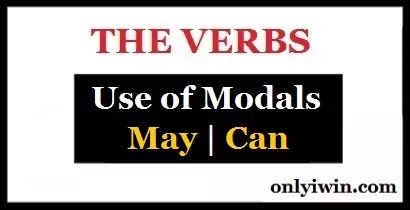Use of Modals: May | Can
Permission हेतु May एवं Can का प्रयोग First-person के साथ निम्न प्रकार होता है
May and Can
1. Permission हेतु May एवं Can का प्रयोग First-person के साथ निम्न प्रकार होता है:I/We के साथ can का बहुत common प्रयोग है।
I can meet the chairman whenever I want. (It means I have already been granted permission.)
I can purchase stationery items whenever I need them. (It means I have already been given authority.)
I can meet the chairman whenever I want. (It means I have already been granted permission.)
I can purchase stationery items whenever I need them. (It means I have already been given authority.)
यद्यपि इस तरह के वाक्यों में may का भी प्रयोग किया जा सकता है। जैसे:
I may purchase stationery items whenever I need them.
I may meet the chairman whenever I want.
I may purchase stationery items whenever I need them.
I may meet the chairman whenever I want.
लकिन ऐसे वाक्यों में May की अपेक्षा Can का प्रयोग अधिक प्रचलित है।
2. Second Person के साथ May का प्रयोग तब किया जाता है जब वक्ता (speaker) द्वारा अनुमति दो गई हो। जैसे:
You may park your vehicle here.
(इसका अर्थ हुआ कि I give you permission to park your vehicle here. It does not mean that you have the authority to park your vehicle here.)
You may park your vehicle here.
(इसका अर्थ हुआ कि I give you permission to park your vehicle here. It does not mean that you have the authority to park your vehicle here.)
Can का प्रयोग II person के साथ उसकी authority को व्यक्त करता है। जैसे:
You can park your vehicle here.
(You have the authority to park your vehicle here.)
You can park your vehicle here.
(You have the authority to park your vehicle here.)
Can का इस तरह प्रयोग, I allow you / the police allow you/ you have an authority or a right to park your vehicle here के अर्थ में होता है। इसी तरह You can take rest in library इसी तरह You have an authority/A competent authority has allowed you.
3. Third Person के साथ may का प्रयोग Speaker द्वारा दी गई permission को व्यक्त करता है। जैसे:
He may take my umbrella.
He may take my scooter.
3. Third Person के साथ may का प्रयोग Speaker द्वारा दी गई permission को व्यक्त करता है। जैसे:
He may take my umbrella.
He may take my scooter.
इस तरह के वाक्यों का अर्थ हुआ कि I give him permission
ऐसे वाक्यों में Can का प्रयोग भी किया जा सकता है।
He can take my car.
He can use my phone.
ऐसे वाक्यों में Can का प्रयोग भी किया जा सकता है।
He can take my car.
He can use my phone.
यहाँ Can का अर्थ subject की authority व्यक्त करता है अर्थात उसे car या phone हेतु कोई Formal Permission आवश्यकता नहीं है। Relation इतने informal एवं close हैं।
An officer can ask a driver to take a vision test.
If allowed, an accused person may appeal against the judgment of the High court.
An accused person can appeal against the judgment of the High court in criminal cases.
Difference Between May and Can
In certain circumstances, an officer may ask a driver to take a vision test.An officer can ask a driver to take a vision test.
If allowed, an accused person may appeal against the judgment of the High court.
An accused person can appeal against the judgment of the High court in criminal cases.
'May' shows the authority given by someone else. 'Can' shows authority lying with the subject.
Difference Between May Not and Can Not
May not का प्रयोग Improbability (सम्भावना नहीं लेकिन है भी) को व्यक्त करता है। जबकि cannot का प्रयोग असम्भावना (Impossibility) को व्यक्त करता है। जैसे:The news may not be true. (may or may not be true.)
The news cannot be true. (There is no possibility of its coming out to be true.)
You may go from A to B, by changing the train at C or you may go by way of D, but you cannot go direct. (As there is no direct route from A to B.)
You cannot go there by water. (As there is no water route.)



Join the conversation